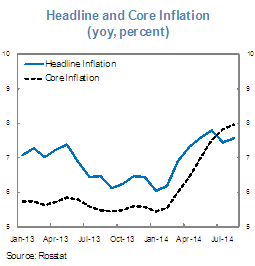 Russian
(PDF)
Russian
(PDF)
Russian Federation: Concluding Statement for the September 2014 Staff VisitOctober 1, 2014Geopolitical tensions are slowing the economy already weakened by structural bottlenecks. In this environment, maintaining sound macroeconomic policies and frameworks would help limit downside risks. The Central Bank of Russia (CBR) should tighten policy rates further to reduce inflation and continue its path towards inflation targeting underpinned by a fully-flexible exchange rate. While the projected overall fiscal stance is appropriately neutral in 2015, the needed fiscal consolidation should resume in the following years. The operational independence of the CBR should be safeguarded and adherence to the fiscal rule should continue. Enhancing Russia’s growth potential requires bold structural reforms and further global integration. The economic outlook appears bleak. GDP is expected to grow by only 0.2 percent in 2014 and 0.5 percent in 2015. Consumption is expected to weaken as real wages and consumer credit growth moderate. Geopolitical tensions—including sanctions, counter-sanctions, and fear of their further escalation—are amplifying uncertainty, depressing confidence and investment. Capital outflows are expected to reach USD 100 billion in 2014 and moderate somewhat but remain high in 2015. Inflation is projected to remain over 8 percent by the end of 2014 mostly due to an increase in food prices, caused by import restrictions, and depreciation of the ruble. In the absence of further policy actions, inflation is expected to stay above target in 2015. Despite the slowdown, the economy is expected to have limited excess capacity owing to structural impediments to growth. Risks are tilted to the downside. Current projections assume a gradual resolution of geopolitical tensions over the next year. Deterioration of confidence, or an escalation or prolongation of geopolitical tensions, could lead to larger capital outflows, greater exchange rate pressure, higher inflation, and lower growth. A reduction in world oil prices could amplify this impact. Maintaining a stable and predictable macroeconomic framework is essential to underpin confidence, especially in the current environment. This includes following the fiscal rule, pursuing the inflation targeting agenda underpinned by a fully-flexible exchange rate regime, and investing the resources of the National Wealth Fund only with appropriate safeguards. Russia has substantial buffers: a large level of reserves, a positive net international investment position, low public debt, and a small general government deficit. However, given the uncertainties about the duration of geopolitical tensions and underlying structural weaknesses, using these buffers wisely is key to providing resilience to the economy.  A tighter monetary stance is required to reduce inflation. The CBR has appropriately raised its policy rates in recent months while resuming the path to greater exchange rate flexibility. However, core inflation has accelerated, implying that monetary tightening is necessary to anchor inflation expectations. Higher interest rates would also help limit capital outflows-especially in an environment of tightening global liquidity-and reduce the bank funding gap by bringing real policy rates firmly into the positive territory. The CBR’s operational independence should be safeguarded. While broad ownership is desirable in setting medium-term inflation goals, the implementation of policies to reach the target should be the exclusive domain of the CBR. A clear mandate will be critical to ensure a credible transition to inflation targeting. Increased oversight and heightened financial stability remain a priority. Banks and the corporate sector are facing a challenging environment due to the weak economy, limited access to external financing, and higher financing costs. Existing financial buffers together with appropriate policy responses by the CBR have limited financial instability thus far. Nonetheless, the current uncertain environment could create difficulties in individual banks and businesses, even in the near term. In case of acute liquidity pressures, emergency facilities should be temporarily offered to eligible counterparties, against appropriate collateral, priced to be solely attractive during stress periods. In the event of market dysfunctions and excessive currency volatility, foreign exchange interventions should also be used without targeting a certain level of the exchange rate The fiscal stance envisioned for 2015 is appropriately neutral. The proposed federal budget, which is consistent with the fiscal rule, envisions a loosening in 2015. However, this is offset by a tightening at the sub-federal levels. This strikes an appropriate balance between the need to consolidate in the medium term, with the non-oil deficit remaining near historical high, and the need for supportive fiscal policy in the face of the current downturn. Adherence to the fiscal framework is essential. The fiscal rule should become a cornerstone of the credibility of macroeconomic institutions. Russia should resist mounting spending pressures and preserve fiscal space for public investment to meet its large infrastructure needs. The use of the National Wealth Fund for domestic infrastructure projects may be appropriate to consider if done in the context of the budget process and subject to appropriate safeguards. The diversion of contributions from the fully-funded pillar weakens the viability of the pension system, creates disincentives to save, and dilutes the credibility of the fiscal rule. Structural reforms are essential in the face of growing uncertainty. Sanctions, counter-sanctions, and heightened uncertainty are leading to additional state interventions in the economy, slowdown in the structural reform agenda, and decreased global integration. Measures to mitigate the impact of geopolitical uncertainties should avoid amplifying existing distortions in the economy. Even if uncertainty dissipates next year, domestic demand and potential growth are projected to remain weak in the medium term due to insufficient investment and deterioration in productivity. Potential growth is projected to be about 1.2 percent in 2015, reaching 1.8 percent in 2019, with downside risks. Structural reforms are needed to provide appropriate incentives to expand investment and allocate resources to enhance efficiency. Protecting investors, reducing trade barriers, fighting corruption, reinvigorating the privatization agenda, improving competition and the business climate, and continuing efforts at global integration remain crucial to revive growth. |

